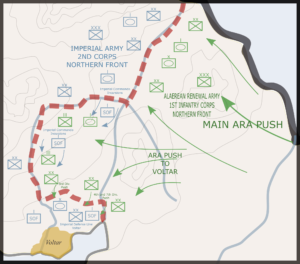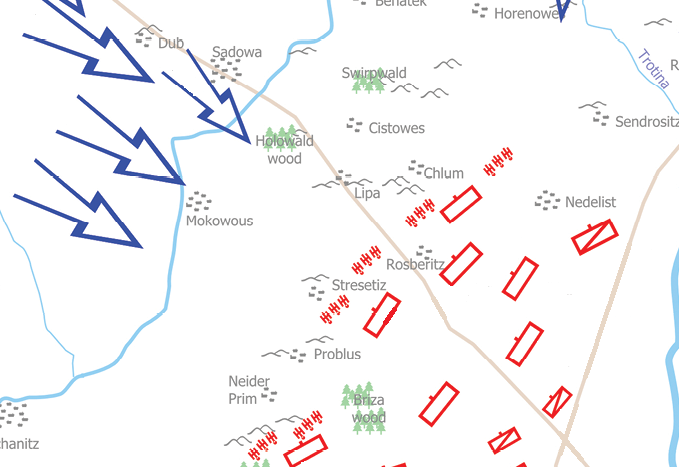
Hi everyone,
Lord Paddington here. I thought I would punctuate my narrative Do’s and Don’ts articles with updates from a campaign I am currently running, so you can see how I try to work out some of the issues I discuss in my articles. In today’s article, I will cover the background and set up for this campaign. If you find anything you like, feel free to use it. If you have any thoughts or suggestions, I am always happy to hear them.
Background:
It had been a few months since my last campaign (I shoot for 3-4 per year to avoid burnout), so I sent out a survey to my local club to see what type of campaign they were interested in (map-based, faction restricted, etc.). The results came in quickly:
The group wanted:
· Roster based (players build an initial roster which is fixed through the campaign; units that are lost are permanently removed)
· Faction restricted
· Planned campaign (a dedicated story that players play through) as opposed to a more open setting
“Okay, that’s fun!”, I thought. I have never done a roster-based campaign before, so time to do some planning. I figured a Chaos vs. Imperium campaign would be the best faction-specific matchup to get the maximum number of players.
Setting and Length:
I needed a Chaos vs. Imperium battleground, somewhere named characters could show up without it being too crazy, and somewhere that could accommodate Primaris marines in the narrative. I settled on creating a fictional planet near the Vigilus system. The story would be the following: this planet had value due to the stable warp lanes around it, making it an ideal place for a flanking maneuver. Thus, it attracted the attention of both sides in this battle.
After doing some initial research into those who were interested, I found 6 players (even numbers are best, so if you are the GM you can have two ringer lists, in case a player from either side can’t get a game in. This is especially important where the players are 30-40 miles apart, as is the case for this campaign)
• Imperium Team: a mix of guard and space marines with one Sororitas player
• Chaos: All CSM with two dedicated Death Guard players (useful for setting up a story)
Additionally, we agreed on a length of 4-6 rounds (2 weeks long each), culminating in an apocalypse battle to end the campaign.
Time to make the initial packet.
Roster Construction
When coming up with how players should build their initial lists I wanted to err on the side of generosity. I had each of the players fill out 2 battalion detachments plus one other detachment of their choice (this ended causing some confusion, but we’ll get to that later). Players didn’t have a point limit on these rosters but were limited to a maximum of 8 dedicated transports per brigade detachment. As intended, this allowed players to customize their armies but still gave them plenty of units to draw from.
Once their lists were ready, I put them all into a google doc that I could edit through the course of the campaign and the players could monitor (the campaign requires a lot of book-keeping)
Content with my roster system, I moved on. I would need a hook to make the campaign interesting, something that could tie the games together and give people an incentive to play – but not an incentive to win at all costs…..
Glory Points:
This was the solution to my problems. The narrative justification is this: both the current Imperial and Chaos Supreme Warlords have had a mediocre record of success, and are on the verge of being “removed”. In this campaign, the players would each nominate an HQ character model (had to be a non-named character) in their army who has an eye for advancement. As they progress through the campaign, they can earn points for their character which can either be used to return destroyed forces or be stored. Glory Points would also be used to determine the winner of the campaign. The side with the most points would win the planet in the story, and the player with the most points on that team would be crowned the overall winner.
These nominated characters also had the benefit of being able to return even after they were killed in battle, though they had to skip a round.
Glory Points are earned through the following ways:
· For every game played against campaign foes during a round: +1
· For every HQ model slain by your nominated warlord: +1
· Submit 1 piece of fluff for your force (min 250 words): +1 per round
However, Glory Points can also be lost…
· If you end the game with only your warlord remaining: -1 (this just seemed like a fun, fluffy idea)
· If you do not play at least 1 game per campaign round: -1 per round (a player could play any game, even against someone who wasn’t part of the campaign and avoid the penalty, providing another incentive for the players to socialize)
Spending Glory Points:
What use is having something you can’t spend (besides hoarding them of course)?
· Return 1 (non-titanic) unit to your roster: 2 Glory Points
· Return your slain Nominated HQ unit without having to wait 1 week: 1 Glory Point
So far I am pretty happy with the rule. I might want to add some way to get a Glory Point via painting but it seems to be working as intended. As a lover of those “Choose Your Own Adventure” books as a kid, I also promised that the Glory Point leader for each side would get to make decisions in unique events at the end of every round. These events would have both gameplay and narrative implications.
Starting the Campaign
So far, so good! I have my setting, I have my interesting campaign hook, and now all I need is a custom mission to really set things off……………..yes, ideas……………………..I’m sure they’ll come………………… annnnnnnnnyyyyyy minute now…………………….
After getting hit with some writer’s block and seeing the deadline for the first round quickly arriving, I settled for the following solution. In the 8th ed, rulebook, there is a table where players each choose an action (Advance, Hold, Reconnoiter, Flank or Reinforce), then reveal their choice simultaneously and use it to determine what battle they will play. I adapted this chart and included it in my mission packet. This would give me some time to give one side a chance to build up some narrative momentum and would serve as a repository of missions should the future missions not prove appetizing.
After about two weeks of planning, I was ready to unleash my fully armed and operational campaign on my eager team of players…
And remember, Frontline Gaming sells gaming products at a discount, every day in their webcart!

